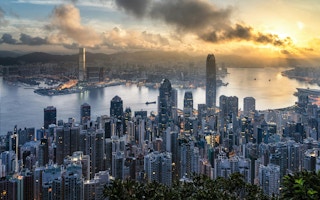Whenever I travel to the Asia Pacific region, I am reminded of both its growing importance to the global economy and its pivotal role in helping the world achieve net-zero carbon emissions.
My recent trips to Hong Kong and Singapore were no exception.
Across both locations, chief executive officers and government leaders wanted to discuss climate-related investment solutions that can accelerate decarbonisation.
Hong Kong and Singapore have long been global financial centres, but now they are competing to become the top climate and sustainability hub for investors in Asia Pacific.
The result has been a burst of new products, companies and platforms that are supporting the net-zero transition — from green bonds and fintech innovators to voluntary carbon markets and exchanges.
Beyond finance and investment, Asia-Pacific leaders are focused on the full spectrum of climate-driven risks and opportunities, and with good reason: Whether we look at physical risk, greenhouse gas (GHG) emissions or net-zero solutions, Asia is central to the global climate challenge.
Consider this startling fact: People in Asia Pacific countries are six times more likely to be affected by a natural disaster than people outside the region, according to the United Nations.
In 2023 alone, they have seen numerous record-breaking heatwaves, including the highest temperatures ever recorded in China, Vietnam, Thailand and Laos. In South Korea, heat-related deaths from mid-May through July more than tripled compared with the same period in 2022.
The past two years have also witnessed record-breaking rainfall and flooding in South Korea, Pakistan and other APAC countries, along with record-breaking drought conditions in China.
To put the elevated risk in perspective, just look at the heatwave that swept through South Asia last April. Scientists with the World Weather Attribution initiative calculate that the risk of such a heatwave in India and Bangladesh has increased by at least a factor of 30 compared with pre-industrial times.
All of this underscores the physical and human consequences of climate change for Asia.
The potential economic and financial consequences are staggering as well.
In one high-emission scenario modelled by the McKinsey Global Institute, Asia would account for roughly 75 per cent of the global capital stock that could be damaged by river flooding in 2050, an amount equal to approximately US$1.2 trillion.
Likewise, the Swiss Re Institute projects that a temperature rise of 2.6 degrees Celsius by 2050 could reduce Asia’s total economic output by more than 20 per cent, including a 29 per cent loss in Southeast Asia. In this scenario, Southeast Asia would suffer more economic damage than any other region on Earth.
Even with just a two degree rise in temperature, more than one-fourth of China would face “medium-to-high or high risk from physical climate impacts”, according to research from MSCI.
Of course, China also accounts for a disproportionate share of global GHG emissions. For that matter, Asia Pacific as a whole accounts for more than 55 per cent of global emissions, and more than three-quarters of coal-fired power generation, according to the UN.
Simply put: We will never reach net-zero emissions without faster progress in this region.
At the same time, Asia Pacific can play an outsized role in developing net-zero solutions.
Many of its largest economies have committed to achieve carbon neutrality by 2050 or 2060, including China (2060), Japan (2050) and South Korea (2050).
More than four years ago, Christian Zinglersen — who now leads the European Union Agency for the Cooperation of Energy Regulators, but was then serving as head of the Clean Energy Ministerial Secretariat — declared that China had become “the undisputable global leader of renewable energy expansion worldwide.”
Indeed, China is on pace to meet its 2030 renewable-capacity target — 1,200 gigawatts of power — five years early, according to Reuters.
Meanwhile, Japan has earned recognition for its contributions to climate finance and clean-energy research. It produced far more renewable-energy patent applications than any other country between 2010 and 2019, according to the World Intellectual Property Organization.
As for South Korea, it is now one of the world’s five biggest producers of low-carbon nuclear power, behind only the U.S., China, France and Russia.
The current government in Seoul has pledged that nuclear will become South Korea’s single largest power source by 2036. More specifically, it hopes to increase nuclear to nearly 35 per cent of power generation, up from 27 per cent in 2021, while increasing the power share of renewables from less than 8 per cent to almost 31 per cent.
Overseas, South Korea is helping the United Arab Emirates build its first-ever nuclear-power plant, as part of a $20-billion project. Once completed, the UAE nuclear plant will supply close to a quarter of the country’s electricity.
The task of decarbonising APAC economies may seem daunting, but climate-related investment tools can help governments and industries navigate the transition.
For example, a new study from the MSCI Sustainability Institute shows how 15 APAC markets — Australia, Bangladesh, China, Hong Kong, India, Indonesia, Japan, Laos, Malaysia, Pakistan, the Philippines, Taiwan, Thailand, South Korea and Vietnam — could pursue an orderly, managed phase-out of coal-fired power plants through 2050.
The simulated pathways would reduce their coal-power emissions by anywhere from 39 per cent to 95 per cent, while reducing their total carbon emissions by 74 per cent, compared with a business-as-usual scenario.
To achieve such decarbonisation economy-wide, the finance and investment industries will have to drive a historic repricing of assets and reallocation of capital.
That has massive implications not only for Hong Kong and Singapore, but also for Shanghai, Beijing, Shenzhen, Tokyo, Seoul, Sydney and other APAC financial centres.
All of these discussions will be front and centre during the COP28 climate summit in Dubai that I am currently attending, which began on November 30. I hope it delivers meaningful results for countries and companies across the region.
Henry Fernandez is the chairman and CEO of MSCI.


















